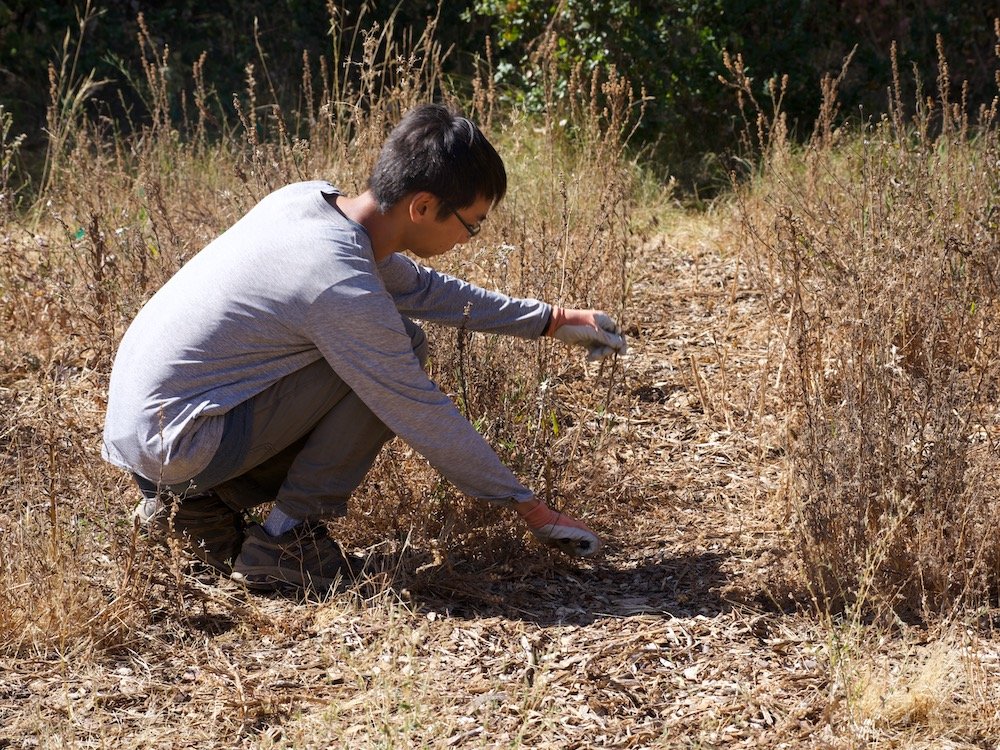Pruning a Native Plant Garden
Volunteers help us install thousands of native plants every year. Pruning, or the removal of dead and unwanted parts of a plant, is a crucial part of maintaining their health. Grassroots Ecology staff recently sharpened their pruning skills at a workshop led by our Nursery Director Deanna Giuliano and Ecologist Siena Watson. Follow their tips below to learn how to prune in your own garden:
Why Prune?
Have you ever seen a tree stump sprouting fresh shoots, or a trimmed hedge pushing out new leaves? Most plants are adapted to disturbance such as pruning, herbivory, or even burning to thrive. These processes remove dead and flammable material, open up sunlight, and spur new growth. Indigenous tribes of California regularly cut back willows and burn elderberry, oaks, grasses, and other plants to boost food production, prevent the buildup of wildfire fuels, and produce straight shoots for basketry, tools, and construction. Use these principles in your own garden to promote plant health, keep your garden tidy, and reduce fire risk.
Stanley deadheading at the Foothills Nature Preserve Lawn Replacement project
1. Decide When to Prune
The best time to prune most California native plants is around early fall, before the rainy season starts. At this time, many of our native plant species have gone dormant, waiting for the return of the rains.
However, certain plants may have different requirements. Early-flowering species such as manzanitas and currants are already preparing next year’s flower buds in early fall, so it is better to prune in the summer before the flower buds appear.
2. Gather and Prepare your Tools
Select the appropriate tool for the width of the stem. You should never have to exert a huge amount of force to make a cut, which can hurt both yourself and the plant.
For the smallest diameter stems, use handheld bypass pruners
For medium stems, use loppers
For larger stems, use a hand saw
For large mature trees, you may want to contact a professional arborist
Pruning with handheld bypass pruners
Sanitizing loppers
To ensure clean cuts, keep your tools sharp using files or other blade-sharpening tools. And to prevent the spread of plant pathogens, sanitize your tools by spraying the blade with 70% isopropyl alcohol or 10% bleach solution when switching between species.
3. Deadhead Spent Flowers
Many plants benefit from deadheading, or the removal of flower stalks, once the flowers have died and gone to seed. This keeps your garden looking neat and provides space for next year’s growth.
Annual wildflowers such as clarkias and arroyo lupine can simply be pulled out or cut away.
Herbaceous perennials like yarrow, mugwort, goldenrod, California aster, and California fuchsia die back each year and resprout from their base in the winter and spring. These can be cut back close to the ground.
Dried goldenrod flowers ready to be deadheaded
Many native bunchgrasses, including purple needlegrass and deergrass, also benefit from being cut back close to the ground. Alternatively, you can use your hands or a rake to pull out the dead stems and leaves.
Shrubs such as sages and California sagebrush can be pruned back to the node (a point where there is a leaf bud) below the flower stalk, which will stimulate fresh growth in the spring.
4. Prune Shrubs and Small Trees
Before pruning woody plants like shrubs and trees, examine the state of each plant and think about how it fits into your overall vision for the garden. Does it have a beautiful branching structure that you want to reveal and highlight? Are the lower branches blocking a pathway or view? Do you want to train the plant upwards, or keep it growing lower? Are there dead or diseased parts? Depending on your goals, you can use one or several of the following techniques. As you prune, occasionally take a step back to assess your progress.
A coyote brush at McClellan Ranch Preserve before pruning
After pruning
Thinning
Thinning is the complete removal of selected stems. This is done to eliminate dead, diseased, crossing, straggly, or crowded branches. Cut close to the base of the stem where it meets the parent branch, leaving a very short collar where the stem widens to let it heal over. Do not leave a long stub, as it could die and invite disease.
Limbing up
Limbing up is the thinning of lower branches on a plant. This can be done to improve views through the garden, reveal the inner branching structure, or reduce the risk that fires spread from the ground into the canopy.
Coppicing
Coppicing is simply cutting the entire plant down to within a few inches of the ground. Certain species, such as coyote brush, coffeeberry, toyon, willows, redbud, and elderberry, will resprout vigorously after coppicing. This can be done to rejuvenate plants that look old or unhealthy.
Heading
If you do not want to coppice a plant, you could use a technique called heading instead. Heading is the shortening of stems, rather than complete removal as with thinning. It can be done to stimulate denser foliage or to shorten lanky and out of place stems.
When heading, the stem should be cut at an angle just above a node, which is a point where there is a leaf bud. This will signal to the plant to regrow from those leaf buds, creating new branches and helping the plant become fuller and more dense with leaves.
Plants with Special Requirements
Certain species, such as manzanitas and ceanothus, do not enjoy heavy pruning. For manzanitas, avoid removing the thicker, more mature branches.
5. Clean Up
Pruned material can be placed in a compost bin or cut up and spread as mulch in the garden. If you want plants to spread on their own, you can scatter the seeds around your garden. Sanitize your tools with alcohol or bleach one last time to prevent the spread of disease and remove any plant sap that could cause rust. Finally, wipe your tools dry and apply a light coat of oil, such as camellia oil or mineral oil, to further protect against rust.
Cleaning up after pruning at Byrne Preserve
The best way to learn is by trial and error. Observe how your plants respond to different cuts, and you will begin to understand what they like and don’t like. With a little practice, your pruning skills will bloom and grow along with your plants!
By Stanley Gu, Ecologist









